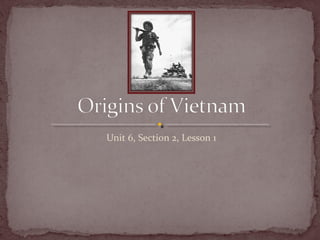
Unit 6 section 2 lesson 1 origins of the vietnam war
- 1. Unit 6, Section 2, Lesson 1
- 2. Objectives • Describe the reasons that the United States helped the French fight the Vietnamese. • Identify ways in which the United States opposed communism in Southeast Asia. • Analyze how the United States increased its involvement in Vietnam.
- 3. Terms and People • Ho Chi Minh − a Vietnamese leader who demanded Vietnam’s independence from France • domino theory − the idea that if Vietnam fell to communism, its closest neighbors would follow • SEATO − the Southeast Asia Treaty Organization, organized to stop the spread of communism in Southeast Asia • Vietcong − National Liberation Front (NLF), South Vietnamese guerrilla fighters supported by communists in North Vietnam • Gulf of Tonkin Resolution − passed in 1964, it gave President Johnson tremendous war powers
- 4. Why did the United States become involved in Vietnam? Presidents Kennedy and Johnson shared a vision that the United States would emerge victorious from the Cold War. As part of this battle, the United States established a new line of defense in Vietnam.
- 5. After World War II, a spirit of nationalism and revolution spread among European colonies around the world. “The oppressed the world over The struggles became are wrestling back their mixed with the Cold War independence. We should conflict. not lag behind… Under the Vietminh banner, let us Such was the case in valiantly march forward!” French Indochina: Laos, Cambodia, and Vietnam. -Ho Chi Minh, 1945 A Vietnamese communist What does Ho Chi Minh named Ho Chi Minh suggest that the people of dreamed of a Vietnam free Vietnam have in common of French Rule. with other peoples who want independence?
- 6. The United States became involved in Vietnam for several reasons. • The U.S. wanted France as an ally in the Cold War. • The U.S. also wanted to support any government that was fighting communism. What caused the war in Vietnam?
- 7. French colonial governments had ruled most of Indochina since the 1800s. The French exploited Indochina’s wealth by owning plantations, claiming mineral rights, and imposing high taxes.
- 8. Vietnamese leader Ho Chi Minh worked to free Vietnam from colonial rule. Unable to get support from western nations, he embraced communism and received support from the communists.
- 9. In 1954, President Eisenhower introduced the domino theory, which said that if Vietnam became communist, its closest neighbors would follow. If communism spread throughout the region, Eisenhower feared, it could threaten Japan, the Philippines, and Australia.
- 10. Despite U.S. financial support, the French were defeated by Vietminh forces at Dien Bien Phu. The Vietminh hammered at French forces and laid siege to the base for 55 days. After suffering more than 15,000 casualties, the French surrendered on May 7, 1954.
- 11. In the peace accord that followed, Cambodia, Laos, and Vietnam gained independence from France.
- 12. Vietnam was divided into two countries. Ho Chi Minh’s communist government ruled North Vietnam. An anticommunist government, supported by the U.S., ruled South Vietnam.
- 13. South Vietnam’s president, Ngo Dinh Diem, was not a popular leader. A group of rebel guerilla fighters formed the National Liberation Front (NLF) to oppose the Diem government and unite Vietnam under communist rule. (NLF flag above.)
- 14. The United States supported South Vietnam in several ways. • formed the Southeast Asia Treaty Organization, which opposed communism • gave economic and military aid • sent Special Forces soldiers to “advise” South Vietnamese troops
- 15. President Kennedy sent Special Forces troops to help fight the Vietcong, the guerilla fighters of the National Liberation Front. The Diem government remained unpopular, however, and the Kennedy administration worked behind the scenes to remove Diem from power.
- 16. President Johnson faced a crisis after he took office. North Vietnam attacked a U.S. destroyer in the Gulf of Tonkin.
- 17. Johnson ordered an airstrike against North Vietnam. He then asked Congress to authorize the use of force to defend U.S. troops. In response, Congress passed the Gulf of Tonkin Resolution.
- 18. The Gulf of • It allowed him to commit U.S. troops Tonkin Resolution to South Vietnam. gave Johnson tremendous war • It enabled him to fight powers. a war against North Vietnam without asking Congress for a declaration of war.